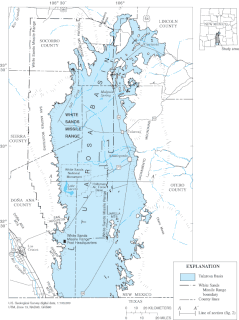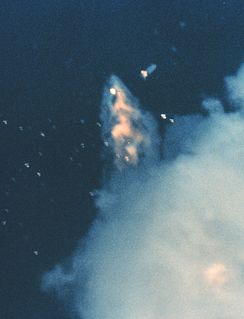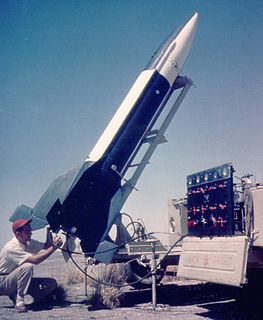Related Research Articles

In telecommunication, a transponder is a device that, upon receiving a signal, emits a different signal in response. The term is a blend of transmitter and responder. It is variously abbreviated as XPDR, XPNDR, TPDR or TP.

Telemetry is the in situ collection of measurements or other data at remote points and their automatic transmission to receiving equipment (telecommunication) for monitoring. The word is derived from the Greek roots tele, "remote", and metron, "measure". Systems that need external instructions and data to operate require the counterpart of telemetry, telecommand.
SMPTE timecode is a set of cooperating standards to label individual frames of video or film with a timecode. The system is defined by the Society of Motion Picture and Television Engineers in the SMPTE 12M specification. SMPTE revised the standard in 2008, turning it into a two-part document: SMPTE 12M-1 and SMPTE 12M-2, including new explanations and clarifications.

The PGM-11 Redstone was the first large American ballistic missile. A short-range ballistic missile (SRBM), it was in active service with the United States Army in West Germany from June 1958 to June 1964 as part of NATO's Cold War defense of Western Europe. It was the first US missile to carry a live nuclear warhead, in the 1958 Pacific Ocean weapons test, Hardtack Teak.

White Sands Missile Range (WSMR) is a military testing area operated by the United States Army. The range was originally established as the White Sands Proving Ground on 9 July 1945. White Sands National Park is located within the range.

Little Joe II was an American rocket used from 1963 to 1966 for five uncrewed tests of the Apollo spacecraft launch escape system (LES), and to verify the performance of the command module parachute recovery system in abort mode. It was named after a similar rocket designed for the same function in Project Mercury. Launched from White Sands Missile Range in New Mexico, it was the smallest of four launch rockets used in the Apollo program.
Inter-range instrumentation group timecodes, commonly known as IRIG timecode, are standard formats for transferring timing information. Atomic frequency standards and GPS receivers designed for precision timing are often equipped with an IRIG output. The standards were created by the Tele Communications Working Group of the U.S. military's Inter-Range Instrumentation Group (IRIG), the standards body of the Range Commanders Council. Work on these standards started in October 1956, and the original standards were accepted in 1960.
Clock synchronization is a topic in computer science and engineering that aims to coordinate otherwise independent clocks. Even when initially set accurately, real clocks will differ after some amount of time due to clock drift, caused by clocks counting time at slightly different rates. There are several problems that occur as a result of clock rate differences and several solutions, some being more appropriate than others in certain contexts.
The Denel Overberg Test Range is a weapons systems testing facility in the Overberg region on the south coast of South Africa, near Arniston, Western Cape. It includes launch pads and tracking systems.
The Downrange Anti-missile Measurement Program or DAMP was an applied research project to obtain scientific data, just prior to and during re-entry, on intermediate- and intercontinental-range ballistic missiles as they returned to earth. The program was funded by the Advanced Research Projects Agency (ARPA) under the technical direction of the Army Ordnance Missile Command (AOMC) during the period 1 January 1959 through 30 September 1963.

Project Hermes was a missile research program run by the Ordnance Corps of the United States Army from November 15, 1944 to December 31, 1954 in response to Germany's rocket attacks in Europe during the Second World War. The program was to determine the missile needs of army field forces. A research and development partnership between the Ordnance Corps and General Electric started November 20, 1944 and resulted in the "development of long-range missiles that could be used against both ground targets and high-altitude aircraft."

In the field of rocketry, range safety may be assured by a system which is intended to protect people and assets on both the rocket range and downrange in cases when a launch vehicle might endanger them. For a rocket deemed to be off course, range safety may be implemented by something as simple as commanding the rocket to shut down the propulsion system or by something as sophisticated as an independent Flight Termination System (FTS), which has redundant transceivers in the launch vehicle that can receive a command to self-destruct then set off charges in the launch vehicle to combust the rocket propellants at altitude. Not all national space programs use flight termination systems on launch vehicles.

The Convair SM-65B Atlas, or Atlas B, also designated X-12 was a prototype of the Atlas missile. First flown on 19 July 1958, the Atlas B was the first version of the Atlas rocket to use the stage and a half design with an operational sustainer engine and jettisonable booster engine section. Unlike later Atlas models, the Atlas B used explosive bolts to jettison the booster section.

The 452d Flight Test Squadron is a United States Air Force squadron. It is assigned to the 412th Operations Group, Air Force Materiel Command, stationed at Edwards Air Force Base, California.
Bus monitoring is a term used in flight testing when capturing data from avionics buses and networks in data acquisition telemetry systems. Commonly monitored avionics buses include

From 1960 to 1988 there were Pershing missile launches for testing from various sites in the US. The systems included the Pershing 1 Field Artillery Missile System, the Pershing 1a Field Artillery Missile System and the Pershing II Weapon System. Initial launches were from what is now the Eastern Range at Cape Canaveral, Florida using Launch Complex 30A using the dismounted erector launcher. Later launches were from the full transporter erector launcher (TEL). Further launches were conducted at White Sands Missile Range (WSMR) using tactical equipment. The Pershing 1 and 1a had a range of 740 kilometres (460 mi), thus launches were from various subinstallations into WSMR. The two-stage Pershing II had a range of 1,770 kilometres (1,100 mi), thus launches at WSMR used a single-stage missile with two-stage launches at Cape Canaveral.

Launch Complex 38 was the White Sands Missile Range facility for testing the Nike Zeus anti-ballistic missile. The site is located east of the WSMR Post Area.
The White Sands Test Center (WSTC) is responsible for planning and conducting tests at White Sands Missile Range (WSMR), New Mexico, USA. WSTC reports to the United States Army Test and Evaluation Command (ATEC). WSMR is designated as an activity within the Department of Defense (DoD) Major Range and Test Facility Base (MRTFB), a core set of DoD Test and Evaluation (T&E) infrastructure and workforce preserved as a national asset to support the DoD acquisition system. The Range possesses capabilities and infrastructure utilized by the US Army, Navy, Air Force and other government agencies as well as universities, private industry, and foreign militaries. As a tri-service facility, WSTC supports the Army by providing data collection and analysis, instrumentation development, modeling and simulation, research assessment, and technical services.

The RTV-A-3 NATIV was an experimental missile developed by North American Aviation for the United States Air Force in the late 1940s to test and evaluate guided missile technologies. The North American Test Instrumentation Vehicle (NATIV) was developed as part of the MX-770 program which was created towards the end of WWII with the intent of developing a long range missile.

Vanguard TV-0, also called Vanguard Test Vehicle-Zero, was the first sub-orbital test flight of a Vanguard rocket as part of the Project Vanguard.
References
- ↑ Range Commanders Council Telemetry Group (June 2013). Telemetry Standards: IRIG Standard 106-13. Document No. 106-13 (Part 1). White Sands Missile Range, New Mexico: Secretariat, Range Commanders Council.
- ↑ Range Commanders Council Telemetry Group (June 2013). "Digital Recording Standard" (PDF). Telemetry Standards: IRIG Standard 106-13. Document No. 106-13 (Part 1). White Sands Missile Range, New Mexico: Secretariat, Range Commanders Council. Chapter 10.
- ↑ Range Commanders Council Range Safety Group (May 2001). Test Standards for Flight Termination Receivers/Decoders. IRIG Standard 313-01. White Sands Missile Range, New Mexico: Secretariat, Range Commanders Council. Archived from the original (pdf) on May 13, 2014.